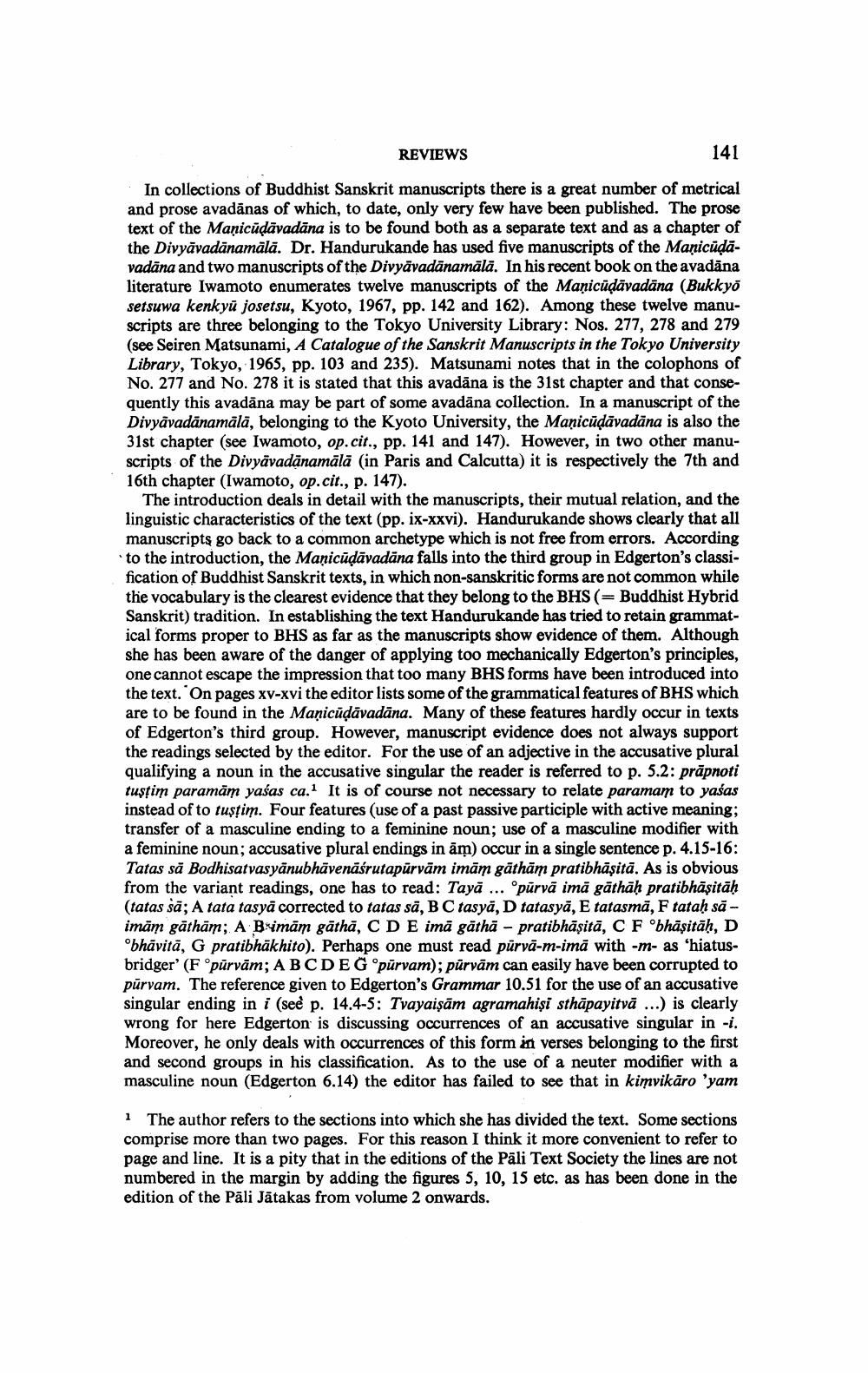Book Title: Reviews Of Different Books Author(s): Publisher: View full book textPage 5
________________ REVIEWS 141 Hanauet free it in Edge In collections of Buddhist Sanskrit manuscripts there is a great number of metrical and prose avadanas of which, to date, only very few have been published. The prose text of the Manicudavadana is to be found both as a separate text and as a chapter of the Divyavadanamala. Dr. Handurukande has used five manuscripts of the Manicudavadana and two manuscripts of the Divyavadanamala. In his recent book on the avadana literature Iwamoto enumerates twelve manuscripts of the Manicudavadana (Bukkyo setsuwa kenkyu josetsu, Kyoto, 1967, pp. 142 and 162). Among these twelve manuscripts are three belonging to the Tokyo University Library: Nos. 277, 278 and 279 (see Seiren Matsunami, A Catalogue of the Sanskrit Manuscripts in the Tokyo University Library, Tokyo, 1965, pp. 103 and 235). Matsunami notes that in the colophons of No. 277 and No. 278 it is stated that this avadana is the 31st chapter and that consequently this avadana may be part of some avadana collection. In a manuscript of the Divyavadanamala, belonging to the Kyoto University, the Manicudavadana is also the 31st chapter (see Iwamoto, op.cit., pp. 141 and 147). However, in two other manuscripts of the Divyavadanamala (in Paris and Calcutta) it is respectively the 7th and 16th chapter (Iwamoto, op.cit., p. 147). The introduction deals in detail with the manuscripts, their mutual relation, and the linguistic characteristics of the text (pp. ix-xxvi). Handurukande shows clearly that all manuscripts go back to a common archetype which is not free from errors. According to the introduction, the Manicudavadana falls into the third group in Edgerton's classification of Buddhist Sanskrit texts, in which non-sanskritic forms are not common while the vocabulary is the clearest evidence that they belong to the BHS (= Buddhist Hybrid Sanskrit) tradition. In establishing the text Handurukande has tried to retain grammatical forms proper to BHS as far as the manuscripts show evidence of them. Although she has been aware of the danger of applying too mechanically Edgerton's principles, one cannot escape the impression that too many BHS forms have been introduced into the text. On pages xv-xvi the editor lists some of the grammatical features of BHS which are to be found in the Manicudavadana. Many of these features hardly occur in texts of Edgerton's third group. However, manuscript evidence does not always support the readings selected by the editor. For the use of an adjective in the accusative plural qualifying a noun in the accusative singular the reader is referred to p. 5.2: prapnoti tustim paramam yasas ca. It is of course not necessary to relate paramam to yasas instead of to tustim. Four features (use of a past passive participle with active meaning; transfer of a masculine ending to a feminine noun; use of a masculine modifier with a feminine noun; accusative plural endings in am) occur in a single sentence p. 4.15-16: Tatas sa Bodhisatvasyanubhavenasrutapurvam imam gatham pratibhasita. As is obvious from the variant readings, one has to read: Taya ... purva ima gathah pratibhasitah (tatas sa; A tata tasya corrected to tatas sa, B C tasya, D tatasya, E tatasma, F tatah saimam gatham; A Bruimam gatha, CDE ima gatha - pratibhasita, CF 'bhasitah, D bhavita, G pratibhakhito). Perhaps one must read purva-m-ima with -m- as 'hiatusbridger' (F Rpurvam; ABCDEG purvam); purvam can easily have been corrupted to purvam. The reference given to Edgerton's Grammar 10.51 for the use of an accusative singular ending in i (see p. 14.4-5: Tvayaisam agramahisi sthapayitva ...) is clearly wrong for here Edgerton is discussing occurrences of an accusative singular in -i. Moreover, he only deals with occurrences of this form in verses belonging to the first and second groups in his classification. As to the use of a neuter modifier with a masculine noun (Edgerton 6.14) the editor has failed to see that in kimvikaro 'yam 1 The author refers to the sections into which she has divided the text. Some sections comprise more than two pages. For this reason I think it more convenient to refer to page and line. It is a pity that in the editions of the Pali Text Society the lines are not numbered in the margin by adding the figures 5, 10, 15 etc. as has been done in the edition of the Pali Jatakas from volume 2 onwards.Page Navigation
1 ... 3 4 5 6 7 8 9 10 11 12 13 14 15
